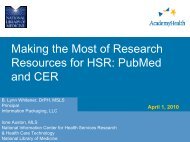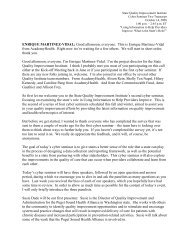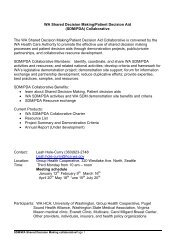Ohio Health Quality Improvement Plan
Ohio Health Quality Improvement Plan
Ohio Health Quality Improvement Plan
Create successful ePaper yourself
Turn your PDF publications into a flip-book with our unique Google optimized e-Paper software.
In f o r m e d a n d ActivatedPa t ie n t s a n d In d iv id u a l spractices and policies of: employers, schools, health care providers, legislators, policy makers, insurers, neighborhoodassociations, and public health officials.• Equity supports a culture of informed and activated patients. It is essential for all actors belonging to the socialenvironment (described above) to understand and address problems of social equity to ensure access to services for allvulnerable groups, including: the poor, disabled, non-English speaking, and racial-ethnic minorities.• Accurate and reliable information must be made available to patients/individuals and providers/teams. Providers andpractice teams must use evidence-based standards, establish common clinical guidelines and evaluation measures.Accurate and reliable information makes it possible for patients to make informed choices and attain optimal health.Additionally, HIT should be leveraged to attain reliable data for practitioners and patients and allow the monitoring ofprogress.• <strong>Health</strong> Literacy must be a priority in order to appropriately engage patients and individuals at various phases intheir life span and those who are differentially involved in their health care. In addition to learning about one’s (or afamily member’s) medical condition, individuals can be encouraged to develop self-care and community-care skills(to incentivize less engaged individuals/patients: training the trainers to do outreach in their communities). Patientswill have access to health resources, personal health records, HIT training, tools and incentives through a workingpartnership with providers, practice teams, public health officials and other health care outreach efforts.• Accountability and Transparency to patients, the public and one another is an essential component of an integratedand collaborative health system. Partnership and dialogue can educate patients on what type of care to expect fromtheir providers and empower them to hold their providers accountable. Additionally, unbiased data that providesinformation about pricing and safety of procedures, devices, and medications, must be a priority.BenefitsPatient activation has the potential to reduce harm; reduce disparities; reduce disease burden; and reduce waste. 8Findings from two separate studies indicate that both patient activation and health literacy contribute to health outcomes. 9While only moderately correlated, both make independent contributions to health behaviors, health choices, and healthoutcomes. <strong>Health</strong> literacy contributes more to choices and the use of information; activation contributes more tohealth behaviors. Another study indicated that activation may help to compensate for lower literacy skill, increasingcomprehension among those with lower literacy. 10There is empirical evidence that giving patients information and involving them in decisions about their health care canresult in beneficial psychological and physical outcomes, including enhanced patient satisfaction, 11 adherence to treatmentplans, 12 and greater confidence in health care recommendations. 13Empirical evidence also suggests that as patients traverse the four stages of activation – (1) the patient does not yet believethat he or she has an active and important role in their health; (2) the patient lacks the confidence and knowledge to takeaction; (3) the patient begins to take action; and (4) the patient maintains behaviors over time – they display behaviorsindicative of becoming fully competent managers of their health. 148 National Partnership. National Priorities and Goals: Patient and Family Engagement. November 2008.9 Hibbard, J.H., Greene, J., & Tusler, M. (2006). An Assessment of Beneficiary Knowledge of Medicare Coverage Options and the Prescription Drug Benefit(Pub I.D. 2006-12). Washington, DC: AARP Public Policy Institute.10 Hibbard, J.H., Peters, E.M., Dixon, A., & Tusler, M. (2007). Consumer competencies and the use of comparative quality information: It isn’t just aboutliteracy. Medical Care Research and Review, 64(4), 379-394.11 Roter, D. L. (‘83). Physician/patient communication: Transmission of information & patient effects. MD State Medical Journal, 32, 260–265.12 Janis, I. (1982). Effective interventions in decision counseling: Implications of the findings from 23 field experiments. In I. Janis (Ed.), Counseling onpersonal decisions: Theory and research on short-term helping relationships. New Haven, CT: Yale University Press.13 Brody, D. S. (1980). The patient’s role in clinical decision making. Annals of Internal Medicine, 93, 718–722.14 Hibbard JH, Mahoney E, Stockard J, Tusler M. (2005). Development and Testing of a Short Form of the Patient Activation Measure (PAM). <strong>Health</strong> ServicesResearch. Vol. 40 No. 6 p.1918-1930.17










